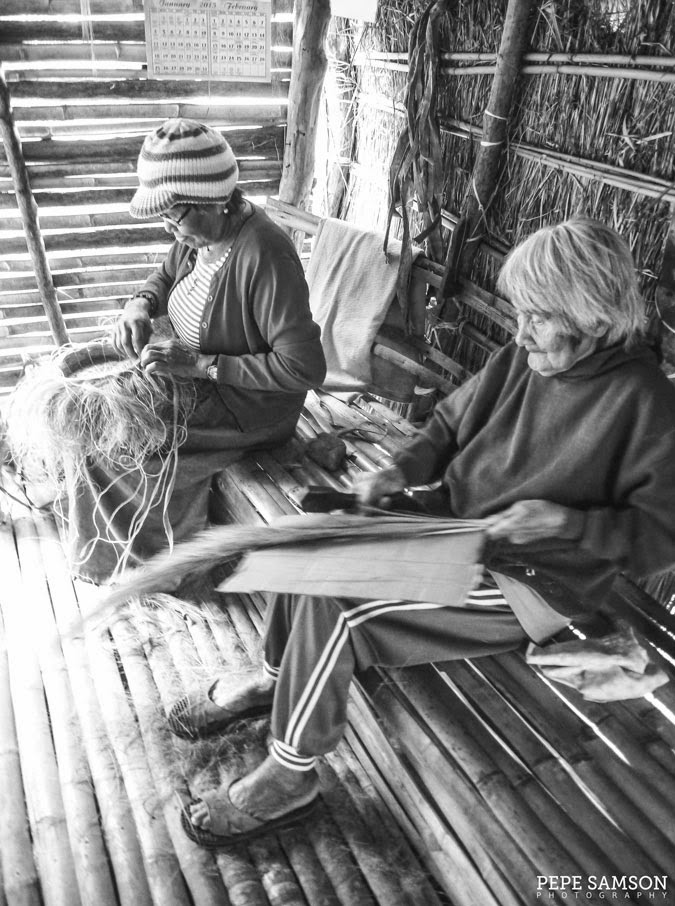Nothing comes close to the feeling of finally getting to your dream destination, so when Philippine Airlines conducted a Batanes seat sale last June, I wasted no time and quickly booked two tickets. I still remember that lucky night: it was 3:00AM, and my travel-junkie officemate sent me a BBM, alerting me of the sale. I hopped into my computer and, fingers crossed, prayed with all my might that there were still discounted seats left. And then, there was it—the golden opportunity! Two tickets for February, PhP2,597 each. I couldn’t believe it—almost one-fifths the normal price! I reserved both, then called up close friends. I decided that whoever answered first would be coming with me to Batanes. Kat’s reply was almost instant.
And then, after months of waiting, saving, researching, and reading blogs, February came. I was in NAIA Terminal 3, queueing up to board the small, 84-seater Bombardier plane. This was smaller than the scary midget plane that took us to Ilocos a few months back, but what the heck. Fuck turbulence, fuck nausea! Nothing was coming between me and Batanes.
-----------------------------------------------------------------------------------------------------
Other posts under "Batanes":
- Where to Eat in Batanes: 5 Restaurants to Try
- Batanes on a Budget: 5 Tips to Maximize Your Batanes Experience
-----------------------------------------------------------------------------------------------------
The hour-and-a-half flight felt longer—I fidgeted constantly, waiting for the pilot to speak into his microphone, to announce our final descent. And then, slowly, amidst the swirls of whites and blues, a mountainous island came into view—rugged yet beautiful, in all shades of green. I‘m in Batanes! I wanted to leap off the plane.
Upon alighting, I took in everything around me. I got my first whiff of the fresh Batanes air, icy but not heavy. A greyish morning, dewy, cold … but inviting. Cold on the skin, but sends warmth all over my body. I was—for real—in Batanes. OMG, I was.
Location
Batanes, the northernmost province of the Philippines, is composed of smaller islands—Batan being the biggest and most populated, nestling the capital, Basco, in its midst. Sabtang is characterized by mountains and beautiful coastlines, a 40-minute boat ride from the Port of Ivana in Batan. Itbayat is “the island with no beach”, which, instead of shorelines, have cliffs surrounding it; it is 3-4 hours away from Batan by boat and has its own airport. A few more islands lie on the northern part of Batanes, but only Batan, Sabtang, and Itbayat are inhabited.
 |
| view from Marlboro country |
USELESS TRIVIA: Batanes is so far north (nearer to Taiwan than to Manila) that when I tried browsing a dating app, all I could see from my grid were Chinese people. LOL!
 |
| #EMOTE at Chamantad-Tinyan Viewpoint in Sabtang |
Climate
Batanes’ coldest months are from December to February—very cold, as low as 17 degrees. It was like being in Sagada, except that Batanes was incredibly windy. And I mean windy.
 |
| Valugang Boulder Beach |
Summer starts in March and continues until May, and during this period there is a drastic change in temperature. According to some locals, some hilly areas lose their green color during summer months. I would say this is unfortunate for tourists, but for the residents, perhaps this is their time to gather cogon and other dried materials they use for construction, making teas, etc.
 |
| sunset in Basco |
By June, the rainy season starts—and I personally wouldn’t want to visit during this period. Batanes’ definition of “normal winds” is equivalent to Manila’s Signal No. 2—trust me, I personally witnessed this. In addition, the already strong waves of Batanes waters will grow even more ferocious with the arrival of storms. During our crossover to Sabtang Island via the Balintang Channel, we observed waves that go almost as high as our boat. Imagine how big they are during rainy season.
 |
| a man steering the faluwa, the traditional Ivatan boat |
There is a misconception that Batanes is always beaten by typhoons because of frequently being mentioned in weather forecasts, but this is not true. The islands only serve as the entry point—thus the reference—but most typhoons do not actually fall there.
Unembellished Beauty
 |
| Chamantad-Tinyan Viewpoint, Sabtang with Kuya Orlan |
There’s a certain kind of peace you will feel once you step foot in Batanes. Everything is incredibly simple, quiet, and pure—Batanes has an in-your-face beauty that will snatch you by the collar and hypnotize you into a sweet surrender.
 |
| Chamantad-Tinyan Viewpoint, Sabtang Island |
Everywhere you look, it’s scenic and picture-perfect. Cows grazing along slanted meadows. The gentle crests of hills, accented by zigzagging trees and shrubs, designed to protect produce and mark ownership. Quiet long roads with one or two locals in motorcycles, and an occasional car, most probably a van full of tourists. Opposite the greens, the endless sea: waves sluggish yet strong and huge. A lighthouse from out of nowhere. Batanes is like a painting you would want to glue your eyes into forever.
 |
| Atop Marlboro country |
 |
| Basco Lighthouse in Naidi Hills |
Stone Houses
Due to harsh weather conditions in the past, Ivatans had learned to adapt really well to their environment. It's the reason why most houses are made of stone, for their homes to withstand the strongest of typhoons. The roofs are made of layers and layers of dried cogon they pick from the mountains. In Sabtang, there are 2 entire villages composed of really cute stone houses (Savidug and Chavayan).
The People
Ivatans are perhaps the kindest, humblest, warmest Filipinos I’ve ever met. Everyone was so friendly and welcoming, it was too good to be true. I was waiting for that moment where these nice people would suddenly all become aswangs and attack me or offer me in a strange ritual, but –it never happened! They were genuinely kind!
The residents are so disciplined; they follow road signs and rules, like honking their vehicles in parts of the road where there is a sharp turn, or opening/closing gates by themselves when there’s a sign that asks them to do so. In Manila, if there’s nobody to watch over the residents (i.e. security guard or traffic enforcer), chaos automatically ensues.
Children in Batanes are respectful and sweet—especially the kids from the municipality of Mahatao, who will take your hand when they see you and put it into their foreheads—the Pinoy custom of “pagmamano”. I was incredibly surprised with this, and just in case you’re wondering, NO, they didn’t ask for money.
Because Batanes is really small and only has 16,000 inhabitants (as of writing), everyone knew each other. You would observe that once you get there—they say hi or blow their horns when they pass by each other. Ivatans are so warm even to tourists; wait until you experience asking directions from or initiating small talk with a local, and you’ll know what I mean. The kindness was overflowing, it was hard not to be influenced by it. In fact, I was smiling all throughout my stay in Batanes.
Modes of Transport
In Basco and Sabtang, the tricycle is the main form of transport. However, the “commute” scene wasn’t anything like Manila, where in you can stand in one corner and hail a trike whenever you need one. In Batanes, you have to send an SMS to the driver in advance so he could pick you up and take you where you want to go.
Almost every resident has his own bike or motorcycle, but you will still find a lot of locals walking long distances to tend their sheep somewhere, check their gardens, take home fresh catches from the sea, or go to school.
Food
Dining out in Batanes can be a bit pricier because of the availability of ingredients. For instance, the island isn’t capable of growing rice because of the climate, so the Ivatans import it and consequently, sell it at higher prices. What they have a lot of are root crops: camote, ube, gabi, carrots, and ginger—which they put in almost everything, from tea to rice to viands. Vegetables are organic, and you can taste the difference when you try a purely veggie dish, like chop suey.
There are only a few dining establishments in Basco, and all of them are worth checking out. Pension Ivatan offers local specialties like Uvud Balls (banana pith), Luñis (Ivatan adobo), and Vunes (dried gabi leaves); Casa Napoli boasts artisanal brick oven pizzas; while Fundacion Pacita, the most expensive hotel in Batanes, is the go-to place for Western-style food, made with local ingredients.
When dining out though, make sure to call first as these restaurants are almost always fully booked. Some of them require reservations, and their menus change daily. Stay tuned for more detailed reviews of these restaurants in the future.
~*~
I’m going to publish a series of posts about my Batanes trip, so expect a lot of photos, as well as detailed reviews of our homestay and yummy food we tried, and of course, things that struck me most about the island and the people. More travel tips are coming as well, including a sample itinerary and expenses report. So stay tuned!
 |
| Mahayaw Arc in Sabtang |
------------------------------------------------------
Read also: Batanes on a Budget
If you like my posts and would love regular updates on travel photos, food finds, restaurant reviews, dance articles, and drunken tales, follow Pepe Samson on Facebook!
















Hi. Do you know when PAL usually offers seat sale? Is it every June?
ReplyDeleteHi Em! I got mine last June (for Feb-Mar travel dates), but I think meron din pag February (Summer and/or Jun-Aug ang travel date). Abang ka na, good luck! :)
ReplyDeleteFirst Impressions... a fitting title. This means that a revisit is in the offing LOL.
ReplyDeleteHaha! This place deserves multiple revisits. 😊 It's like a humbler, less virgin (???) Sagada, plus lots of alon hahaha. Tara!
ReplyDeleteSino kaya yung travel-junkie officemate...LOL
ReplyDeleteHahaha! Uy malapit ka naaaaaaaa! Enjoy!
ReplyDeleteYou have a great Batanes trip.
ReplyDeleteThanks Benedict for dropping by! Keep returning for more Batanes articles. :)
ReplyDelete